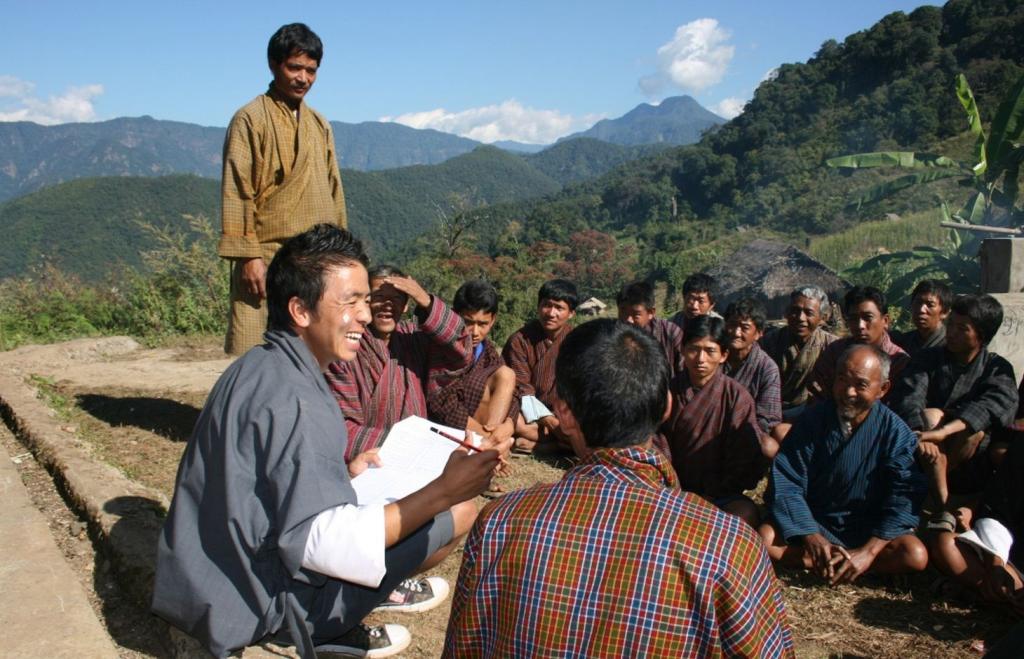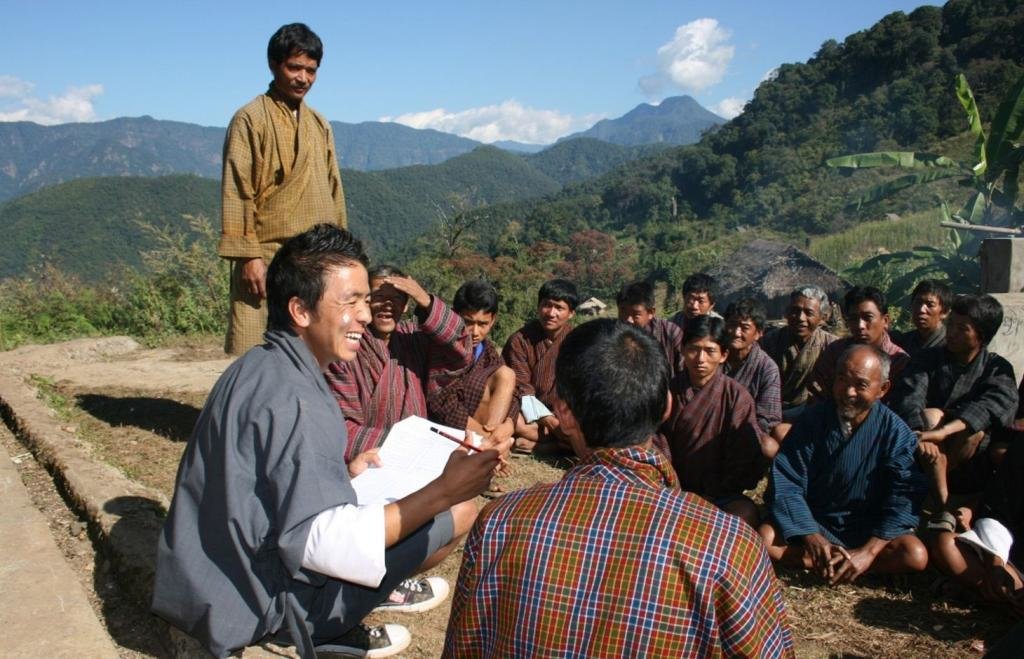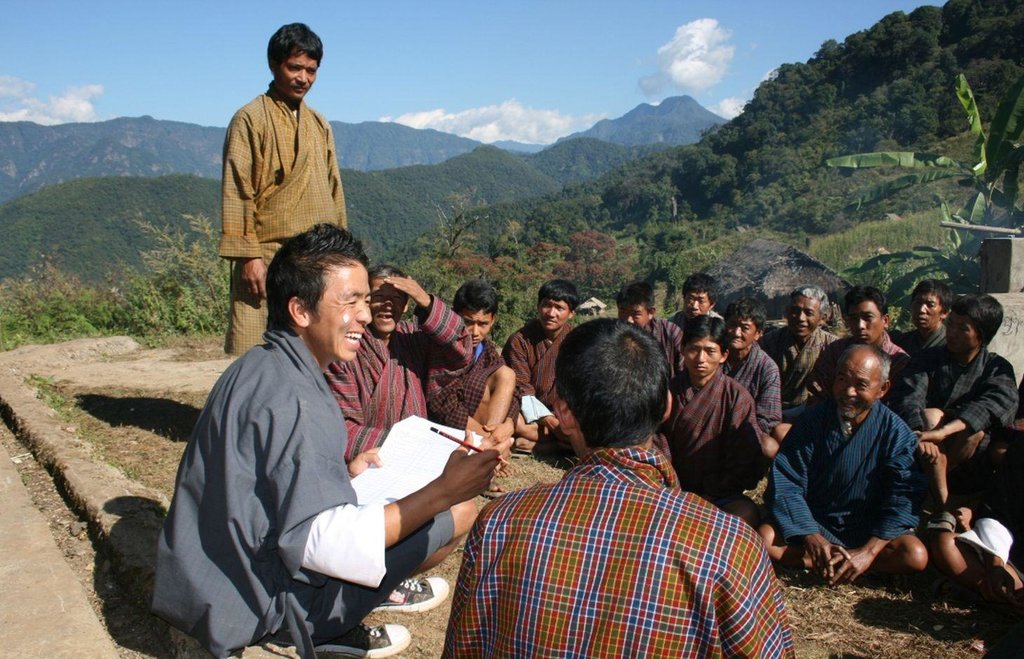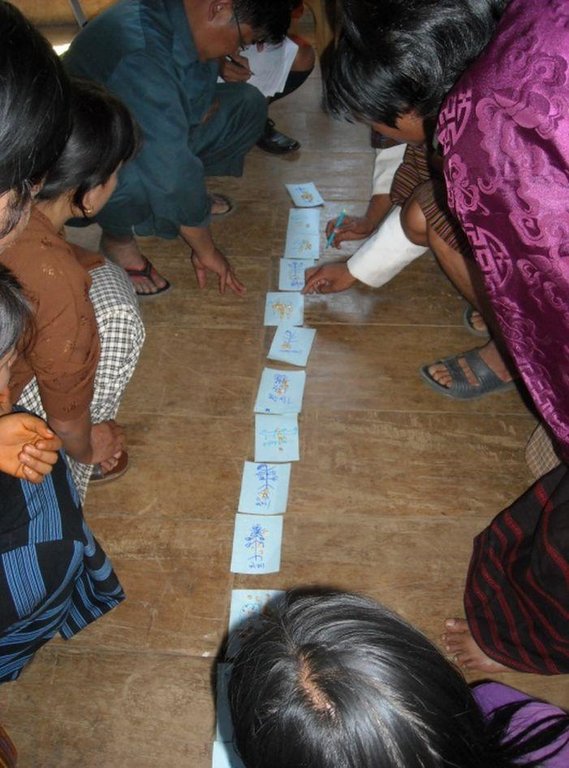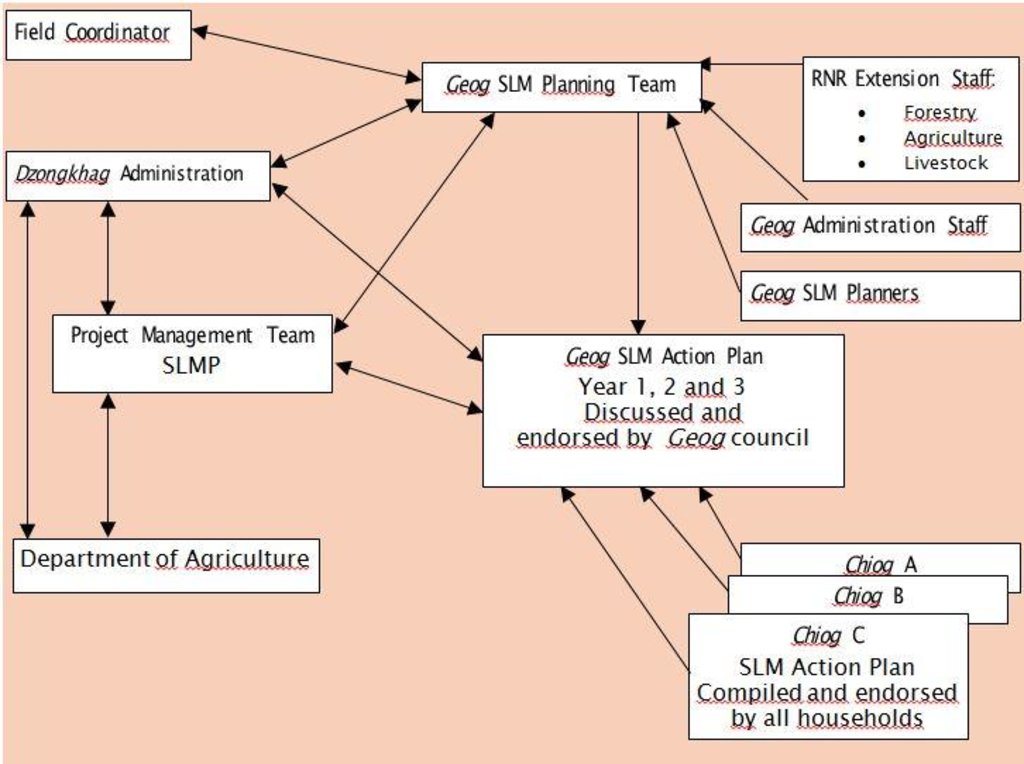Participatory SLM Action Planning [ภูฏาน]
- ผู้สร้างสรรค์:
- การอัพเดท:
- ผู้รวบรวม: Karma Dorji
- ผู้เรียบเรียง: –
- ผู้ตรวจสอบ: Fabian Ottiger
approaches_2489 - ภูฏาน
ดูส่วนย่อย
ขยายทั้งหมด ย่อทั้งหมด1. ข้อมูลทั่วไป
1.2 รายละเอียดที่ติดต่อได้ของผู้รวบรวมและองค์กรที่เกี่ยวข้องในการประเมินและการจัดเตรียมทำเอกสารของแนวทาง
ผู้เชี่ยวชาญ SLM:
Wangdi Tashi
NSSC, DoA, MoAF, RGoB
ภูฏาน
ผู้เชี่ยวชาญ SLM:
Dorji Tshering
NSSC, DoA, MoAF, RGoB
ภูฏาน
ชื่อของโครงการซึ่งอำนวยความสะดวกในการทำเอกสารหรือการประเมินแนวทาง (ถ้าเกี่ยวข้อง)
National Soil Services Centre (National Soil Services Centre) - ภูฏานชื่อของโครงการซึ่งอำนวยความสะดวกในการทำเอกสารหรือการประเมินแนวทาง (ถ้าเกี่ยวข้อง)
MoA (MoA) - ภูฏาน1.3 เงื่อนไขที่เกี่ยวข้องกับการใช้ข้อมูลที่ได้บันทึกไว้ผ่านทาง WOCAT
วันที่เก็บรวบรวมข้อมูล (ภาคสนาม):
14/03/2011
ผู้รวบรวมและวิทยากรหลักยอมรับเงื่อนไขเกี่ยวกับการใช้ข้อมูลที่ถูกบันทึกผ่านทาง WOCAT:
ใช่
2. คำอธิบายของแนวทาง SLM
2.1 การอธิบายแบบสั้น ๆ ของแนวทาง
A methodology to identify in a participatory manner at village level land-based problems, its causal factors and mitigation measures to reduce land degradation and enhance rural livelihoods
2.2 การอธิบายอย่างละเอียดของแนวทาง
การอธิบายอย่างละเอียดของแนวทาง:
Aims / objectives: Participatory SLM Action Planning (SLM AP) is a methodology that aims at prioritiz-ing possible SLM interventions to mitigate the most critical land degradation issues. Priorities are based on the identification of land-based livelihoods and livelihood resources, the key area-based problems and their causes. SLM AP is carried out in the SLMP geogs (block) at chiog (village) level, including all community households. It involves elements of PRA/PLA such as problem census, cropping calendars, history lines, natural resource mapping and builds on the in-depth knowledge and understanding of farming households of their land, their problems and opportunities. The process is highly visual to include the illiterate and very interactive by giving the communities the lead in prioritizing their problems and deciding on SLM interventions.
Methods: The SLM AP is an iterative process, starting with building and training SLM planning teams (GSPTs) at geog level, comprising of extension staff and locally recruited geog SLM planners (GSPs) and geog administration staff. The GSPTs start awareness and mobilization activities in the first year at geog council level. This is followed by a 3 day SLM AP in each and every chiog of the geog to compile a chiog SLM action plan. The village SLM APs are combined into a geog SLM AP and discussed, amended and endorsed in a public meeting by the geog council. The necessary budget is allocated by SLMP project and implementation of the planned activities takes place at chiog level.
Stages of implementation: Implementation is preceded by intensive training and capacity building of the communities in SLM activities. In the second year a new SLM AP round is made, lasting only one day, with review of the previous SLM AP at chiog level. Potential new activities are identified, based on field experiences, to complete the new SLM AP for year 2. In the final year 3, a last SLM AP round is made in all chiogs to compile chiog and ultimately a geog SLM AP.
Role of stakeholders: SLM AP is an inclusive process and gender sensitive, with focus on vulnerable households. The approach includes participatory Natural Resource mapping at chiog level and participatory Monitoring & Evaluation to track implementation progress and impact and to get feedback of the communities.
Other important information: Environmental and social screening procedures are applied to exclude any negative impact on the land or on social groups. SLM AP was piloted in 3 geogs in 3 Dzongkhags since 2006 and has been rolled out to more than 130 chiogs in 9 geogs.
2.3 รูปภาพของแนวทาง
2.5 ประเทศ ภูมิภาค หรือสถานที่ตั้งที่ได้นำแนวทางไปใช้
ประเทศ:
ภูฏาน
ภูมิภาค/รัฐ/จังหวัด: :
Chhukha, Trashigang and Zhemgang Dzongkhags
ข้อมูลเฉพาะเพิ่มเติมของสถานที่ตั้ง:
9 separate geogs
2.6 วันที่เริ่มต้นและสิ้นสุดของแนวทาง
ระบุปีที่เริ่ม:
2006
การสิ้นสุดลง (ถ้าแนวทางไม่ได้ใช้อีกต่อไป):
2012
2.7 ประเภทของแนวทาง
- ใช้โครงงานหรือแผนงานเป็นฐาน
2.8 เป้าหมายหรือวัตถุประสงค์หลักของแนวทาง
The Approach focused mainly on SLM with other activities (livelihoods, cash income, food security, capacity building, awareness raising)
- To build community capacity to assess land degradation and identify and prioritize mitigation measures
- Enhancement of rural livelihoods
The SLM Approach addressed the following problems: - Lack of awareness of land degradation processes, combined with limited technical knowledge to tackle its causes.
- Planning procedures are top-down and do not incorporate land-based issues adequately and fail to build local ownership and sustainability.
2.9 เงื่อนไขที่เอื้ออำนวยหรือเป็นอุปสรรคต่อการนำเทคโนโลยีภายใต้แนวทางนี้ไปปฏิบัติใช้
การมีไว้ให้หรือการเข้าถึงแหล่งการเงินและบริการ
- เป็นอุปสรรค
Large amount of cash to handle at municipality level
Treatment through the SLM Approach: Training, monitoring and limitation of cash amounts
การจัดตั้งระดับองค์กร
- เป็นอุปสรรค
Delays in financial releases to decentralised level because of lengthy/complicated administrative chain
Treatment through the SLM Approach: Training of key financial staff to shorten procedure and minimize frequency of budget releases
กรอบแนวทางในการดำเนินการด้านกฎหมาย (การถือครองที่ดิน สิทธิในการใช้ที่ดินและน้ำ)
- เอื้ออำนวย
The existing land ownership, land use rights / water rights helped a little the approach implementation: Individual land titles of households favour greatly the planning and implementation of SLM activities
- เป็นอุปสรรค
Lack of efforts in implementing SLM technologies on land without ownership and living as tenants
Treatment through the SLM Approach: Awareness on the importance of proper management to prevent decline in productivity and their own livelihoods through loss of soil fertility and or loss of land physically due to landslides and mass movements.
ความรู้เกี่ยวกับ SLM การเข้าถึงการสนับสนุนด้านเทคนิค
- เป็นอุปสรรค
Awaraness of communities and technical confidence of teams
Treatment through the SLM Approach: Training and capacity buidling
ปริมาณงานที่ทำได้ กำลังคนที่มีให้
- เป็นอุปสรรค
Large volume of work, especially in growing season
Treatment through the SLM Approach: Make of use of lean winter season for labour-intensive SLM interventions
อื่นๆ
- เป็นอุปสรรค
Small land holding sizes to spare a portion for SLM technologies
Treatment through the SLM Approach: Awareness on the advantages of SLM
3. การมีส่วนร่วมและบทบาทของผู้มีส่วนได้ส่วนเสียที่เกี่ยวข้อง
3.1 ผู้มีส่วนได้ส่วนเสียที่เกี่ยวข้องในแนวทางนี้และบทบาท
- ผู้ใช้ที่ดินระดับท้องถิ่นหรือชุมชนระดับท้องถิ่น
communities of all chiogs
In all villages the most vulnerable community members were identified (wealth / well-being ranking), ranked and specific effort made to include them in most interventions, where possible.
- ผู้เชี่ยวชาญ SLM หรือที่ปรึกษาการเกษตร
- ครู เด็กนักเรียน หรือนักศึกษา
- รัฐบาลระดับท้องถิ่น
GSPT and Dzongkhag staff (Local government)
- รัฐบาลแห่งชาติ (ผู้วางแผน ผู้ทำการตัดสินใจ)
RGoB, MoAF, DoA
- องค์การระหว่างประเทศ
GEF, World Bank
- monk body
3.2 การเกี่ยวข้องของผู้ใช้ที่ดินระดับท้องถิ่นหรือชุมชนระดับท้องถิ่นในช่วงต่างๆของแนวทาง
| ความเกี่ยวข้องของผู้ใช้ที่ดินระดับท้องถิ่นหรือชุมชนระดับท้องถิ่น | ระบุผู้ที่มีส่วนเกี่ยวข้องและอธิบายกิจกรรม | |
|---|---|---|
| การริเริ่มหรือการจูงใจ | ปฏิสัมพันธ์ | National level stakeholders in consultation with district and municipality staff developed the methodology through an iterative consultation process |
| การวางแผน | ปฏิสัมพันธ์ | Decentralised training and planning of SLM interventions at chiog level (130+ chiogs) in 9 geogs in 3 Dzongkhags |
| การดำเนินการ | ปฏิสัมพันธ์ | Range of SLM and livelihood activities at chiog level (130+ villages) during 6 year project period |
| การติดตามตรวจสอบหรือการประเมินผล | ปฏิสัมพันธ์ | Regular participatory M&E at chiog and geog level |
| Research | ไม่ลงมือ | Few focused SLM related research topics commissioned to governmental research institutions |
3.3 แผนผังแสดงขั้นตอนการทำงาน (ถ้ามี)
คำอธิบาย:
Overview of network of Stakeholders at chiog (village), geog and district level
ผู้เขียน:
Hans van Noord (Schoutenkamp 43 Heteren The Netherlands)
3.4 การตัดสินใจเลือกใช้เทคโนโลยี SLM
ระบุผู้ที่ทำการตัดสินใจเลือกเทคโนโลยีมากกว่าหนึ่งวิธีไปปฏิบัติใช้:
- ผู้ใช้ที่ดินเป็นผู้ตัดสินใจหลัก โดยการสนับสนุนจากผู้เชี่ยวชาญ SLM
การอธิบาย:
Decisions on the method of implementing the SLM Technology were made by mainly by SLM specialists with consultation of land users. The SLM planning was done in a very participatory manner with the land users as they best know the problems in their land i.e. where, how, when, etc. Planning done using participatory planning tools and field visits. Based on the problems at the site (site specific problems) then SLM Specialists make problem specific recommendations of SLM technologies. The main Monitoring and Evaluation was done after every six months when comprehensive information was collected with structured questionnaires along with site visits and meeting with the communities. M&E was also done as frequently as possible even while visiting the site for other purposes during the year without compulsory group meetings.
4. การสนับสนุนด้านเทคนิค การสร้างขีดความสามารถ และการจัดการด้านความรู้
4.1 การสร้างขีดความสามารถ / การอบรม
ได้มีการจัดอบรมให้แก่ผู้ใช้ที่ดินหรือผู้มีส่วนได้ส่วนเสียคนอื่น ๆ หรือไม่:
ใช่
ให้ระบุว่าใครเป็นผู้ได้รับการอบรม:
- ผู้ใช้ที่ดิน
- เจ้าหน้าที่ภาคสนาม / ที่ปรึกษา
- Project management staff
รูปแบบการอบรม:
- กำลังดำเนินการ
- เกษตรกรกับเกษตรกร
- ใช้พื้นที่ทำการสาธิต
- จัดการประชุมสู่สาธารณชน
- จัดคอร์ส
หัวข้อที่พูด:
Extensive training programmes for project management staff and field coordinators and the decentralised extension staff (forestry, livestock and agriculture) at geog level together with the geog administration staff and finally to all chiog communities (130+). Initial training was on SLM action planning and Natural Resource mapping; later on a range of technical intervention such as hedgerow establishment, check dam construction, bioengineering, afforestation, community forestry, fodder development, bamboo plantation, bench terracing etc.
4.2 การบริการให้คำแนะนำ
ผู้ใช้ที่ดินมีการเข้าถึงการรับบริการให้คำปรึกษาหรือไม่:
ใช่
ระบุว่ามีบริการให้คำปรึกษาหรือไม่:
- ไปเยี่ยมชมสถานที่
การอธิบาย/แสดงความคิดเห็น:
Name of method used for advisory service: SLM planning knowledge transfer; Key elements: participatory planning, capacity and skills building of RNR extension staff; Whole range of extension advisory services by all extension teams related to SLM, cash generation and group formation
Advisory service is quite adequate to ensure the continuation of land conservation activities; Capacity built, awareness raised, institutions supported. Adequate human and institutional capacities and awareness have been created during the GEF/World Bank SLM Project period and the effort is still being continued. The actual implementation of the SLM technologies in the field is constrained by inadequate fund support and small land holdings.
4.3 การเสริมความแข็งแกร่งให้กับสถาบัน (การพัฒนาองค์กร)
สถาบันได้รับการจัดตั้งขึ้นมาหรือเสริมความแข็งแกร่งโดยแนวทางนี้หรือไม่:
- ใช่ เล็กน้อย
ระบุระดับของสถาบันที่ได้รับการเสริมความแข็งแกร่งหรือจัดตั้งขึ้นมา:
- ท้องถิ่น
ระบุประเภทของการให้ความช่วยเหลือสนับสนุน:
- การสร้างขีดความสามารถ / การอบรม
- อุปกรณ์
- curriculum development support, seeds, seedlings
ให้รายละเอียดเพิ่มเติม :
Moderate support to monk body, schools, Non-Formal Education and geog administrations
4.4 การติดตามตรวจสอบและประเมินผล
การติดตามตรวจสอบและประเมินผลเป็นส่วนหนึ่งของแนวทางหรือไม่:
ใช่
ความคิดเห็น:
bio-physical aspects were regular monitored by project staff through observations; indicators: Regular measurements and observations of acreage of improved vulnerable land through SLM interventions; annual soil erosion plot measurements
bio-physical aspects were regular monitored by project staff through measurements; indicators: Regular measurements and observations of acreage of improved vulnerable land through SLM interventions; annual soil erosion plot measurements
technical aspects were regular monitored by project staff through observations; indicators: Regular measurements and observations of acreage and properties of specific areas of improved vulnerable land
technical aspects were regular monitored by project staff through measurements; indicators: Regular measurements and observations of acreage and properties of specific areas of improved vulnerable land
socio-cultural aspects were regular monitored by project staff, land users through observations; indicators: Regular observations through participatory M&E meetings
economic / production aspects were regular monitored by project staff through observations; indicators: Regular observations and measurements by field extension staff (crop cut, animal production, volume of bamboo marketed; CBA study to establish economic viability
economic / production aspects were regular monitored by project staff through measurements; indicators: Regular observations and measurements by field extension staff (crop cut, animal production, volume of bamboo marketed; CBA study to establish economic viability
area treated aspects were regular monitored by project staff, land users through measurements; indicators: Regular measurements of area treated: range of project indicators for vulnerable land improved
no. of land users involved aspects were ad hoc monitored by project staff, government through measurements; indicators: Regular measurements of households and farmers (male/female) participating
management of Approach aspects were regular monitored by None through observations; indicators: WB, MTAC, Regular reviews with key stakeholders (Annual Review Workshops)
There were several changes in the Approach as a result of monitoring and evaluation: Two-tier approach: combination of inclusion of all household combined with limited areal focus; vulnerable households focus; financial disbursement system; ch more cash-generating activities; more group/community focus; labour-saving machinery
There were few changes in the Technology as a result of monitoring and evaluation: change of type and variety of seeds and seedlings
4.5 การวิจัย
การวิจัยเป็นส่วนหนึ่งของแนวทางหรือไม่:
ใช่
ระบุหัวข้อเรื่อง:
- สังคมวิทยา
- เศรษฐศาสตร์หรือการตลาด
- นิเวศวิทยา
ให้ข้อมูลเพิ่มเติมและให้ระบุผู้ทำการวิจัย:
Little involvement, apart from some focused research on group formation at chiog level and studies on CBA, SLM-poverty linkage, rangeland management, rural-urban transition etc.
Research was carried out both on station and on-farm
5. การสนับสนุนด้านการเงินและวัสดุอุปกรณ์
5.1 ระบุงบประมาณประจำปีสำหรับแนวทาง SLM นี้
ถ้าหากว่างบประมาณประจำปีไม่เป็นที่ทราบแน่นอน ให้ระบุช่วงลงไป:
- > 1,000,000
แสดงความคิดเห็น (แหล่งของการระดมทุน ผู้บริจาคคนสำคัญ):
Approach costs were met by the following donors: international (GEF-World Bank): 70.0%; government (RGoB): 20.0%; local community / land user(s): 10.0%
5.2 การสนับสนุนด้านการเงิน / วัสดุอุปกรณ์ให้แก่ผู้ใช้ที่ดิน
ผู้ใช้ที่ดินได้รับการสนับสนุนด้านการเงิน / วัสดุอุปกรณ์ไปปฏิบัติใช้เทคโนโลยีหรือไม่:
ใช่
ถ้าใช่ ให้ระบุประเภทของการสนับสนุน เงื่อนไขและผู้จัดหามาให้:
Incentives for specific SLM interventions per area and through short-term input support (seeds and seedlings)
5.3 เงินสนับสนุนสำหรับปัจจัยนำเข้า (รวมถึงแรงงาน)
- อุปกรณ์
| ระบุปัจจัยนำเข้าที่ได้รับการสนับสนุน | เห็นด้วยระดับไหน | ระบุเงินสนับสนุน |
|---|---|---|
| เครื่องมือ | ได้รับการช่วยเหลือทางการเงินบางส่วน | |
- การเกษตร
| ระบุปัจจัยนำเข้าที่ได้รับการสนับสนุน | เห็นด้วยระดับไหน | ระบุเงินสนับสนุน |
|---|---|---|
| เมล็ด | ได้รับการช่วยเหลือทางการเงินบางส่วน | |
| Seedlings | ได้รับการช่วยเหลือทางการเงินบางส่วน | |
- วัสดุสำหรับการก่อสร้าง
| ระบุปัจจัยนำเข้าที่ได้รับการสนับสนุน | เห็นด้วยระดับไหน | ระบุเงินสนับสนุน |
|---|---|---|
| for fencing and dams | ได้รับการช่วยเหลือทางการเงินบางส่วน | |
- โครงสร้างพื้นฐาน
| ระบุปัจจัยนำเข้าที่ได้รับการสนับสนุน | เห็นด้วยระดับไหน | ระบุเงินสนับสนุน |
|---|---|---|
| FYM sheds, irrigation channel renovation | ได้รับการช่วยเหลือทางการเงินบางส่วน | |
ความคิดเห็น:
Mostly voluntary and some paid in cash (for labour-intensive SLM interventions) and limited other material support such as tools and seeds and seedlings
Not financed: roads, fertilizers, schools
5.4 เครดิต
มีการจัดหาเครดิตมาให้ภายใต้แนวทาง SLM หรือไม่:
ไม่ใช่
6. การวิเคราะห์ผลกระทบและการสรุป
6.1 ผลกระทบของแนวทาง
ช่วยให้ผู้ใช้ที่ดินนำเอาเทคโนโลยี SLMไปใช้และบำรุงรักษาสภาพไว้ได้หรือไม่:
- ไม่ใช่
- ใช่ เล็กน้อย
- ใช่ ปานกลาง
- ใช่ อย่างมาก
Considerable area of vulnerable land brought under SLM, reduction of loss of land, improved yields, improved income, improved animal production, improved fodder base
ทำให้กลุ่มด้อยโอกาสมีอำนาจทางสังคมและเศรษฐกิจหรือไม่:
- ไม่ใช่
- ใช่ เล็กน้อย
- ใช่ ปานกลาง
- ใช่ อย่างมาก
Moderate improvement of vulnerable households (poorest and single-headed households) through targeted interventions and pro-active inclusion. The labour sharing approach in implementing SLM activities greatly benefited the resource (human and capital) constrained household.
ปรับปรุงประเด็นของการถือครองที่ดินหรือสิทธิในการใช้ ซึ่งขัดขวางการนำเทคโนโลยีไปใช้ให้ดีขึ้น:
- ไม่ใช่
- ใช่ เล็กน้อย
- ใช่ ปานกลาง
- ใช่ อย่างมาก
The problem is unlikely to be overcome in the near future. Individual land titles of households favour greatly the planning and implementation of SLM activities
Did other land users / projects adopt the Approach?
- ไม่ใช่
- ใช่ เล็กน้อย
- ใช่ ปานกลาง
- ใช่ อย่างมาก
Other government and donor-funded projects have adopted elements of the participatory SLM action planning methodology (DANIDA, REAP)
Did the Approach lead to improved livelihoods / human well-being?
- ไม่ใช่
- ใช่ เล็กน้อย
- ใช่ ปานกลาง
- ใช่ อย่างมาก
cash income, food self-sufficiency, community sense/bonding, reduced exposure to natural hazards related to land degradation/flooding
Did the Approach help to alleviate poverty?
- ไม่ใช่
- ใช่ เล็กน้อย
- ใช่ ปานกลาง
- ใช่ อย่างมาก
Improvement of food self-sufficiency and cash generation opportunities
6.2 แรงจูงใจหลักของผู้ใช้ที่ดินเพื่อที่จะนำ SLM ไปปฏิบัติใช้
- การผลิตที่เพิ่มขึ้น
- ภาระงานลดลง
- การจ่ายเงินหรือการช่วยเหลือ
- เกียรติภูมิ แรงกดดันทางสังคม ความเชื่อมแน่นทางสังคม
- การเข้าร่วมสมทบในขบวนการ โครงการ กลุ่ม เครือข่าย
- จิตสำนึกด้านสิ่งแวดล้อม
- well-being and livelihoods improvement
6.3 ความยั่งยืนของกิจกรรมของแนวทาง
ผู้ใช้ที่ดินสามารถทำให้สิ่งต่างๆ ที่ได้ปฏิบัติใช้โดยแนวทางนี้ยั่งยืนได้หรือไม่ (โดยไม่มีการสนับสนุนจากภายนอก):
- ไม่แน่ใจ
ถ้าตอบว่าไม่หรือไม่แน่ใจ ให้ระบุและแสดงความคิดเห็น :
Rural communities will need continued support by government staff through advice, finance and other support.
6.4 จุดแข็งและข้อได้เปรียบของแนวทาง
| จุดแข็ง / ข้อได้เปรียบของแนวทางในทัศนคติของผู้รวบรวมหรือวิทยากรหลัก |
|---|
|
Decentralised, village level bottom-up planning and implementation ensures capacity building, ownership and empowerment of rural land users Participatory character gives a voice to farmers with in-depth knowledge of land-based issues and its causes and history Inclusiveness of approach, reaching to all households Helps to build community sense (How to sustain/ enhance this strength: Continued annual AP Continued annual AP; add with NR mapping and ITK studies and participatory M&E Continued annual AP; targeted focus on most vulnerable households Additional group formation and community group support ) |
6.5 จุดอ่อน / ข้อเสียเปรียบของแนวทางและวิธีในการแก้ไข
| จุดอ่อน / ข้อเสียเปรียบในทัศนคติของผู้รวบรวมหรือวิทยากรหลัก | สามารถแก้ไขปัญหาได้อย่างไร |
|---|---|
|
Time-consuming and resource demanding Requires large workload of both extension staff and farmers Costly as the approach also covers actual implementation of all of planned SLM activities and reaches more than 130 villages for 3 year period |
Combine and align with Five Year Plan planning procedures; mainstreaming into governmental decentralised planning procedures Mainstreaming into regular planning and budgeting Spread over calendar year; labour-intensive SLM activities in lean winter season. |
7. การอ้างอิงและการเชื่อมต่อ
7.1 วิธีการหรือแหล่งข้อมูล
- ไปเยี่ยมชมภาคสนาม การสำรวจพื้นที่ภาคสนาม
- การสัมภาษณ์กับผู้ใช้ที่ดิน
7.2 การอ้างอิงถึงสิ่งตีพิมพ์
ชื่อเรื่อง ผู้เขียน ปี ISBN:
Working the Land - Documenting the Key Lessons of Sustainable Land Management on Steep to Very Steep Slopes in Bhutan 2011
ช่องทางในการสืบค้น และราคา:
NSSC, DoA, MoAF, RGoB
ชื่อเรื่อง ผู้เขียน ปี ISBN:
Indigenous Technical Knowledge (ITK) on Soil & Soil Fertility Management 2011
ช่องทางในการสืบค้น และราคา:
NSSC, DoA, MoAF, RGoB
ชื่อเรื่อง ผู้เขียน ปี ISBN:
Participatory Approaches in Sustainable Land Management – Planning, Implementation & Monitoring as Continuous Learning Processes 2011
ช่องทางในการสืบค้น และราคา:
NSSC, DoA, MoAF, RGoB
ชื่อเรื่อง ผู้เขียน ปี ISBN:
National Action Plan to Combat Land Degradation 2010, 2014
ช่องทางในการสืบค้น และราคา:
NSSC, DoA, MoAF, RGoB
ชื่อเรื่อง ผู้เขียน ปี ISBN:
BHUCAT, Best Practices and Guidelines from Bhutan for SLM on Steep to very Steep Slope
ช่องทางในการสืบค้น และราคา:
NSSC, DoA, MoAF, RGoB
ชื่อเรื่อง ผู้เขียน ปี ISBN:
Documentary of the achievements made in SLM through SLM Project
ช่องทางในการสืบค้น และราคา:
NSSC, DoA, MoAF, RGoB
ชื่อเรื่อง ผู้เขียน ปี ISBN:
Bhutan Land Cover Assessment 2010-Technical Report, NSSC, 2011
ช่องทางในการสืบค้น และราคา:
NSSC, DoA, MoAF, RGoB
ชื่อเรื่อง ผู้เขียน ปี ISBN:
Soil Erosion – Measurement and analysis of soil erosion plot data, NSSC, 2010, 2011
ช่องทางในการสืบค้น และราคา:
NSSC, DoA, MoAF, RGoB
ชื่อเรื่อง ผู้เขียน ปี ISBN:
Integrated Biodiversity Survey of the Lower Wangchhu Watershed, Bhutan 2010
ช่องทางในการสืบค้น และราคา:
NSSC, DoA, MoAF, RGoB
ชื่อเรื่อง ผู้เขียน ปี ISBN:
Rangeland Management in Bhutan 2009
ช่องทางในการสืบค้น และราคา:
NSSC, DoA, MoAF, RGoB, A consultancy report
ชื่อเรื่อง ผู้เขียน ปี ISBN:
Study on Poverty Sustainable Land Management Linkages in Bhutan-A consultancy Report-2009 2009
ช่องทางในการสืบค้น และราคา:
NSSC, DoA, MoAF, RGoB, A consultancy report
ชื่อเรื่อง ผู้เขียน ปี ISBN:
Sustainable Land Management Participatory Action Planning Manual & Tool Kit 2009
ช่องทางในการสืบค้น และราคา:
NSSC, DoA, MoAF, RGoB, A consultancy report
ชื่อเรื่อง ผู้เขียน ปี ISBN:
Sustainable Land Management Interventions: Cost Benefit Analysis Report 2009
ช่องทางในการสืบค้น และราคา:
NSSC, DoA, MoAF, RGoB, A consultancy report
ชื่อเรื่อง ผู้เขียน ปี ISBN:
Rural Livelihoods and Peri-Urban Analysis 2008
ช่องทางในการสืบค้น และราคา:
NSSC, DoA, MoAF, RGoB, A consultancy report
ชื่อเรื่อง ผู้เขียน ปี ISBN:
Review of Mainstreaming of sustainable Land Management in Government Policies and Plans in Bhutan 2008
ช่องทางในการสืบค้น และราคา:
NSSC, DoA, MoAF, RGoB, A consultancy report
ลิงก์และโมดูล
ขยายทั้งหมด ย่อทั้งหมดลิงก์
ไม่มีลิงก์
โมดูล
ไม่มีโมดูล


